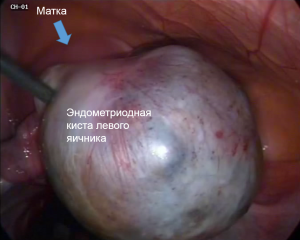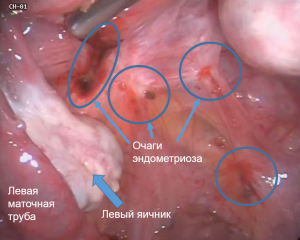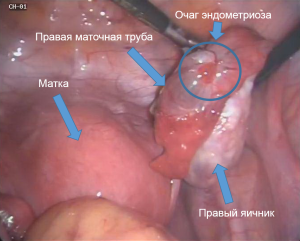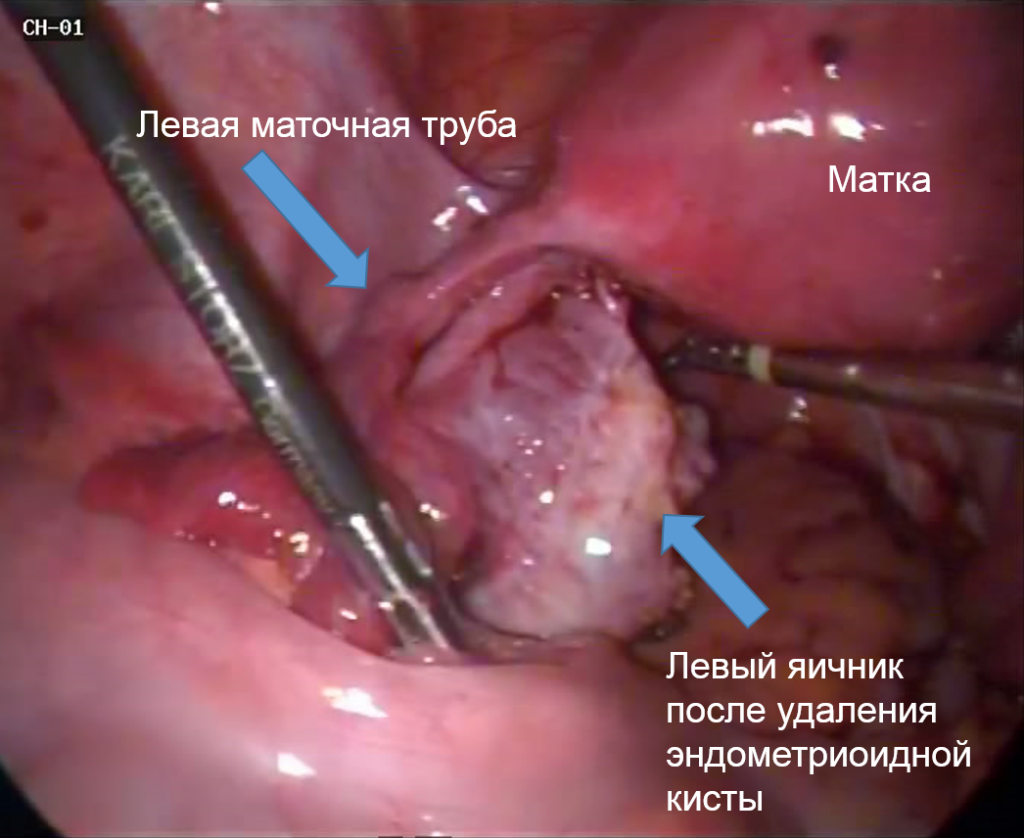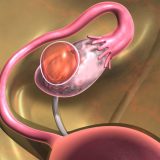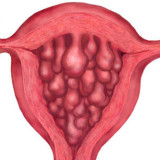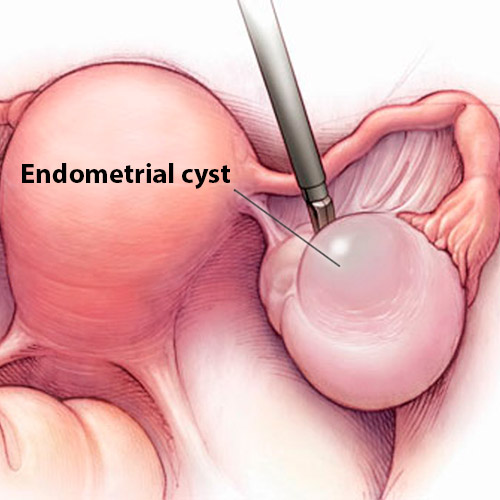
- Most Often affects young, nulliparous women
- Often causes pain
- Can lead to infertility
- Almost always affects several organs
- Promptly Treated only
- May appear again
- Can lead to increased tumor markers
What:
- Make Sure that you luteum cyst (they can be similar). To do this, again, consult an expert
- Find a place for surgery
- After surgery, do not forget the hormonal treatment
And now everything in detail!
Endometrial cyst of the ovary (endometrioma, “chocolate” cyst) refers to a group of diseases called “endometriosis”, and is considered one of the most insidious. This is due to the characteristics of the course of endometriosis.
Features of endometriosis
To make it easier to understand what is happening with endometriosis changes, first tell the essence of this pathology.
The Internal surface of the uterus is called the “endometrium”. During the menstrual cycle it melts, thickens and is preparing to receive a fertilized egg. If during the month the pregnancy does not occur, then all this mass of overgrown endometrium sloughs and menstruation begins. Now, if the cells of the endometrium (or rather identical), are NOT in the uterus, and in other places, it’s a condition called “endometriosis”.
Around such endometriotic lesions begin to form a special type of inflammation (non-infectious, without microbes), which leads to the formation of adhesions, pain and infertility.
The Formation of endometriotic cysts starts with a small endometriotic foci on the surface of the ovary. Under the influence of female sex hormones during each menstrual cycle this lesion increases in size (about as well as every month, the endometrium grows in the uterus). Inside focus during menstruation accumulates a small amount of blood and begins to form a cyst. Accumulating blood eventually turns into a dark brown mass, reminiscent of chocolate (hence another name endometrioid cysts – “chocolate cyst”).
Causes of endometriotic cyst of the ovary.
Since endometriosis is completely dependent on the female sex hormones, endometrial cyst occurs mainly in young age (most often 25-40 years). Significant role for genetic predisposition to this disease. But the main risk nulliparous women (or those who postpone pregnancy until later). This is due to a large number of periods throughout life. Because genetically female body is coded by only a small amount of menstruation. And most of time it needs to be either pregnant or breastfeeding. Modern life changes the natural course of events that inevitably leads to a rise in hormone-dependent gynecological diseases (endometriosis, uterine fibroids, etc.). Read more about this in the article the causes of ovarian cysts.
Diagnosis of endometrial cysts of the ovary.
Endometrial cyst of the ovary is usually well seen with ultrasound examination. The “chocolate” that appears in the cyst is due to the breakdown of blood on the ultrasound looks like a white slurry on a dark background.
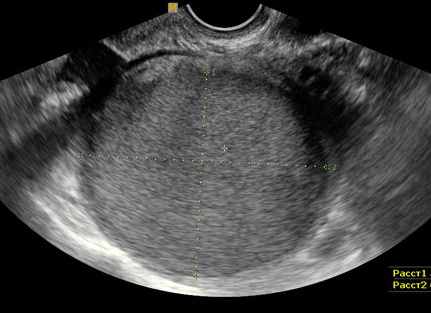
But the biggest problem is that exactly the same look and some other cysts.
The Accumulation of blood in a yellow body eventually gives exactly the same picture. And to distinguish the old luteum cyst from endometrioid very difficult. In order nevertheless to deal with the diagnosis you have some time to observe the patient. Luteum cyst over time on their own (or hormonal treatment) takes place. For 1-3 months or she completely disappears or is significantly reduced in size. With endometrioid cyst during this time, virtually nothing happens, or it may even grow. Very rarely, hormonal therapy, it may decrease slightly, but it does not disappear completely.
Another cyst that gives a similar picture on the ultrasound is a dermoid cyst. Only in her white slurry on a dark background gives not old blood, and the fat that is always contained in a dermoid cyst. If you suspect a dermoid cyst, you need to do an MRI in a special mode that allows you to see fatty tissue.
When the endometrial cyst (as with any other) necessary to conduct blood tests on the level of tumor markers. With endometriosis often increases the level of CA-125 (100 U/ml), but this does not mean that you have cancer. It’s just such a feature of the disease.
Symptoms of endometrial cysts of the ovary.
Endometriosis is its various manifestations. Will focus on the most typical symptoms of endometrial cysts of the ovary.
Many patients note pain. Most often it is pain in the abdomen, in the projection of the cysts that appear before and/or at the beginning of menstruation. Such pain is related to the fact that endometriosis fall off during menstruation tissue are not only in the uterus, but in endometrioid lesions (cyst). Accordingly, the total area of the exfoliating cells increased. And this inevitably leads to aggravation of pain during menstruation.
With widespread endometriosis, pain during sexual intercourse. Such a pain is because endometriosis almost always affects multiple organs and causes the formation in the pelvis adhesions (adhesions between different authorities). Also around endometriotic lesions always proceeds inflammation (non-infectious, that is, without microbes!).
To avoid this, in addition to qualitatively performed the operation, after removal of endometriotic cysts needed hormonal treatment. Since all endometrial tissue grows only under the influence of its own hormones, this treatment helps stop the growth of endometriosis and gives the body an opportunity to get rid of all microscopic lesions. In the Arsenal of gynecologists today there are a large number of such preparations. No need to fear that you will recover and start growing a mustache and hair loss. All the myths of the last century. They have nothing in common with modern drugs. Don’t believe? So you still can’t find a gynecologist who will help you choose proper and safe treatment.
How to avoid relapse (re-growth) endometrioid cysts.
Unfortunately, endometriosis is a chronic disease, so he can return and give the new growth of cysts. In order to mitigate this risk, you need to have a good surgeon and a competent outpatient gynecologist (preferably a gynecologist, endocrinologist). This two-link chain. Even if qualitatively endometrial cyst removed, the operation is supplemented by excision of all endometriotic lesions, it is, in fact, the surgeon removes the consequence but not the cause of the disease.
After surgery for patients with endometriosis essential 2 things: pregnancy (preferred) or hormonal drugs. They act on the root cause of the appearance of endometriosis remain the best way to as primary prevention of occurrence and recurrence of the cyst. Do not neglect this, and endometriosis can never come back into your life.
If you are planning pregnancy after surgery, your actions depend on the prevalence of endometriosis. For small forms of endometriosis when removed only the endometrial cyst and a small number of superficial endometriotic lesions on the peritoneum, the pregnancy, you can plan immediately (even without treatment). But attempts to get pregnant by yourself should not exceed 1-2 years. After this period, you need to do IVF.
With widespread endometriosis, immediately after surgery it is good hormone treatment and it is better to think about IVF. According to the world statistics is the best way to handle the issue of pregnancy in severe endometriosis. A long attempt to conceive a child only lead to delay, and relapse. Moreover, at each recurrence of the disease (and operations) is much more complicated than the previous case.
The Solution.
Considering the fact that endometrial cyst occurs most frequently in young age, on the basis of foreign experience my technique was introduced by careful removal of the cyst. The main task is to keep the maximum healthy ovarian tissue and resect all visible endometriotic lesions.
In practice, this gives a number of advantages:
- Ability to have children, because preserved ovarian reserve
- Lack of weight gain because the ovaries continue to maintain normal hormone levels
- Elasticity and youthfulness of the skin, because that is a responsibility ovarian estrogens
- Saving of sexuality and a good relationship with your partner, because pain disappear
- Excellent health, no depression and mood swings, because there are no changes in hormone levels
- Preventing the development of many serious diseases (cardiovascular, diabetes, diseases of the joints) because ovarian estrogens protect your body
- Quick rehabilitation after operations, because we use modern anesthesia
- Reduced risk of surgical complications, because we use disposable and qualitative tools
- Good tolerance to surgery because we practice only the noninvasive techniques
- Excellent cosmetic effect, because we impose intradermal sutures that don’t even need to remove
- Prevention of cancer, because we remove all potentially dangerous pockets
